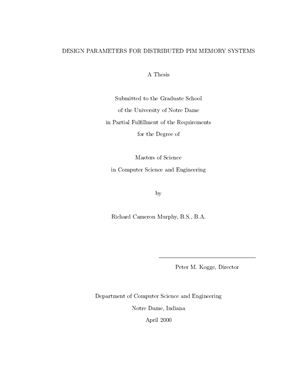Диссертация (Master), University of Notre Dame, 2000, -220 pp.
Processing-In-Memory (PIM) circumvents the von Neumann bottleneck by combining logic and memory (typically DRAM) on a single die. This work examines the memory system parameters for constructing PIM based computers which are capable of solving significant problems. Using several data intensive benchmarks, simulations demonstrate that PIMs are capable of supporting enough data to be multicomputer nodes. Additionally, the results show that even data intensive code exhibits a large amount of inteal spatial locality. A mobile thread execution model is presented that takes advantage of the tremendous amount of inteal bandwidth available on a given PIM node and the locality exhibited by the application. Communication and other overhead is also discussed.
Introduction
A Brief Review of the State of the Art
The Benchmarks
Spatial Overhead
Working Set Critical Mass
Communication and Data Distribution
Code, Threads, Context, and Carpet Bags
A: Benchmark Instruction Frequencies
B: Unabridged Working Set CIPD (?(L)) Results
C: Unabridged Working Set Page Miss Rate Results
D: Unabridged Remote Name Translation Mechanismresults
E: Unabridged Carpet Bag Cache Miss Rate Results for the Image Understanding Benchmark
Processing-In-Memory (PIM) circumvents the von Neumann bottleneck by combining logic and memory (typically DRAM) on a single die. This work examines the memory system parameters for constructing PIM based computers which are capable of solving significant problems. Using several data intensive benchmarks, simulations demonstrate that PIMs are capable of supporting enough data to be multicomputer nodes. Additionally, the results show that even data intensive code exhibits a large amount of inteal spatial locality. A mobile thread execution model is presented that takes advantage of the tremendous amount of inteal bandwidth available on a given PIM node and the locality exhibited by the application. Communication and other overhead is also discussed.
Introduction
A Brief Review of the State of the Art
The Benchmarks
Spatial Overhead
Working Set Critical Mass
Communication and Data Distribution
Code, Threads, Context, and Carpet Bags
A: Benchmark Instruction Frequencies
B: Unabridged Working Set CIPD (?(L)) Results
C: Unabridged Working Set Page Miss Rate Results
D: Unabridged Remote Name Translation Mechanismresults
E: Unabridged Carpet Bag Cache Miss Rate Results for the Image Understanding Benchmark

